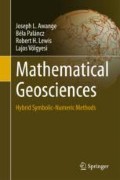Abstract
In many fields such as robotics (Poppinga in International conference on intelligent robots and systems (IROS). IEEE Press 2008), computer vision (Mitra and Nguyen in SoCG’03. pp 322–328, 2003), digital photogrammetry (Yang and Förtsner in Technical report. Nr.1, department of photogrammetry institute of geodesy and geo-information. Uni., Bonn, Germany, 2010), surface reconstruction (Nurunnabi et al. in ISPRS annals of the photogrammetry, remote sensing and spatial information sciences. Melbourne, Australia, pp 269–275, 2012), computational geometry (Lukács et al. in ECCV’98. Springer-Verlag, pp 671–686, 1998) as well as in the increasing applications of laser scanning ((Stathas et al. in Proceedings 11th international fig symposium on deformation measurements. Santorini, Greece, 2003), it is a fundamental task for extracting features from 3D point cloud. Since the physical limitations of the sensors, the occlusions, multiple reflectance and noise can produce off-surface points, robust fitting techniques are required. Robust fitting means an estimation technique which is able to estimate accurate model parameters not only despite small-scale noise in the data set but occasionally large scale measurement errors (outliers). Outliers definition is not easy.
References
Beder C, Förstner W (2006) Direct solutions for computing cylinders from minimal sets of 3d points, computer vision-ECCV 2006. Lect Notes Comput Sci 3951:135–146
Carrea D, Jaboyedoff M, Derron MH (2014) Feasibility study of point cloud data from test deposition holes for deformation analysis. In: Working report 2014–01, Universite de Lausanne (UNIL)
DalleMole V, do Rego R, Araújo A (2010) The self-organizing approach for surface reconstruction from unstructured point clouds. In: Matsopoulos GK (Ed) Self-Organizing Maps
Draelos MT (2012) The kinect up close: modifications for short-range depth imaging. In: A thesis Master of Science, Electrical Engineering, Raleigh, North Carolina
Fischler MA, Bolles RC (1981) Random sample consensus: a paradigm for model fitting with applications to image analysis and automated cartography. Commun ACM 24(6):381–395
Fox A, Smith J, Ford R, Doe J (2013) Expectation Maximization for gaussian mixture distributions. In: Wolfram Demonstration Project
Franaszek M, Cheok G, Saidi KS, Witzgall C (2009) Fitting spheres to range data from 3-D imaging systems. IEEE T. Instru Meas 58(10):3544–3553
Khameneh M (2013) Tree detection and species identification using LiDAR data. In: MSc. Thesis, KTH, Royal Institute of Technology, Stockholm
Kohonen T (1998) The self-organizing map. Neurocomputing 21:1–6
Krarup T, Kubik K, Juhl J (1980) Götterdammerung over least squares. In: Proceeding of international society of photogrammetry 14th Congress, Hamburg, pp 370–378
Lichtblau D (2006) Cylinders through five points: complex and real enumerative geometry, Conference Paper August 2006, DOI:10.1007/978-3-540-77356-6_6 Source: DBLP conference: automated deduction in geometry, 6th international workshop, ADG 2006, Pontevedra, Spain, August 31-September 2, 2006
Lichtblau D (2012) Cylinders Through five points computational algebra and geometry automated deduction in geometry. J. Mathe Res 4:65–82 Published by Canadian Center of Science and Education
Lukacs G, Martin R, Marshall D (1998) Faithful least-squares fitting of spheres, cylinders, cones and tori for reliable segmentation. In: Burkhardt H, Neumann B (eds) Computer Vision -ECCV’98, vol I. LNCS 1406, Springer-Verlag, pp 671–686
Mitra NJ, Nguyen (2003) SoCG’03, June 8–10, San Diego, California, USA, ACM 1-58113-663-3/03/0006, pp 322–328
Molnár B, Toth CK, Detrekoi A (2012) Accuracy test of microsoft kinect for human morphological measurements. In: International archives of the photogrammetry, remote sensing and spatial information sciences, vol XXXIX-B3, 2012 XXII ISPRS Congress, 25 August—01 September 2012, Melbourne, Australia
Nurunnabi A, Belton D, West G. (2012) Diagnostic—robust statistical analysis for local surface fitting in 3D point cloud data. In: ISPRS annals of the photogrammetry, remote sensing and spatial information sciences, vol. I-3, 2012 XXII ISPRS Congress, 25 Aug. 2012, Melbourne, Australia, pp 269–275
Paláncz B (2014) Fitting data with different error models. Mathe J 16:1–22
Petitjean S (2002) A survey of methods for recovering quadrics in triangle meshes. ACM Comput Surv 34(2):211–262
Poppinga J, Vaskevicius N, Birk A, Pathak K (2008) Fast plane detection and polygonalization in noisy 3D range images. In: International conference on intelligent robots and systems (IROS), Nice, France, IEEE Press 2008
Rose C, Smith D (2000) Symbolic Maximum Likelihood Estimation with Mathematica. Statistician 49:229–240
Ruiz O, Arroyave S, Acosta D (2013) Fitting Analytic Surfaces to Noisy Point Clouds. Am. J. Comput Mathe 3:18–26
Stal C, Timothy Nuttens T, Constales D, Schotte K, De Backer H, De Wulf A (2012) Automatic filtering of terrestrial laser scanner data from cylindrical tunnels, TS09D—Laser Scanners III, 5812. In: FIG Working Week 2012, Knowing to manage the territory, protect the environment, evaluate the cultural heritage, Rome, Italy, May 2012, pp 6–10
Stathas D, Arabatzi O, Dogouris S, Piniotis G, Tsini D, Tsinis D (2003) New monitoring techniques on the determination of structure deformation. In: Proceedings 11th international fig symposium on deformation measurements, Santorini, Greece
Su YT, Bethel J (2010) Detection and robust estimation of cylinder features in point clouds. In: ASPRS 2010 annual conference, San Diego, California April 26–30
Vosselman G, Gorte B, Sithole G, Rabbani T (2004) Recognizing structure in laser scanner point clouds. In Int. Arch Photogrammetry Remote Sensing Spatial Inf Sci 46:33–38
Winkelbach S, Westphal R, Goesling T (2003) Pose estimation of cylinder fragments for semi-automatic bone fracture reduction. In: Pattern Recognition (DAGM 2003). Michaelis B and Krell G eds. Lecture Notes in Computer Science, vol 2781, Springer-Verlag, pp 566–573
Yang MY, Förtsner W (2010) Plane detection in point cloud data, TR-IGG-P-2010-01. In: Technical report. Nr.1, department of photogrammetry institute of geodesy and geo-information, Uni., Bonn, Germany
Zuliani M (2012) RANSAC for dummies, www.vision.ece.ucsb.edu/~zuliani
Author information
Authors and Affiliations
Rights and permissions
Copyright information
© 2018 Springer International Publishing AG
About this chapter
Cite this chapter
Awange, J.L., Paláncz, B., Lewis, R.H., Völgyesi, L. (2018). Robust Regression. In: Mathematical Geosciences. Springer, Cham. https://doi.org/10.1007/978-3-319-67371-4_13
Download citation
DOI: https://doi.org/10.1007/978-3-319-67371-4_13
Published:
Publisher Name: Springer, Cham
Print ISBN: 978-3-319-67370-7
Online ISBN: 978-3-319-67371-4
eBook Packages: Earth and Environmental ScienceEarth and Environmental Science (R0)

